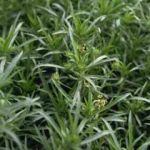| Common Name: |
Spanish Psyllium |
| Other Names: |
Fleaseed, Fleawort |
| Botanical Name: |
Plantago psyllium |
| Genus: |
Plantago |
| Family: |
Plantaginaceae |
| Native Location: |
Mediterranean |
| Cultivation: |
Well-drained soil in sun (P. asiatica, P. psyllium); moist soil in sun or partial shade (P. major) Plantago major is prone to powdery mildew in dry conditions. |
| Propagation: |
By seed sown in autumn or spring. Plantago major and variants self-seed freely and spread from borders into lawns and paths. Variants come reasonably true from seed. |
| Harvest: |
Plants are cut during the growing season and used fresh, as juice, or dried for decoctions (P. asiatica). Leaves are cut before flowering and dried for infusions, liquid extracts, and tinctures (P. major). Ripe seeds are dried for decoctions and powders. |
| Height: |
60cm (24in) |
| Width: |
30cm (12in) |
| Hardiness: |
Hardy |
| Parts Used: |
Seeds |
| Properties: |
A sweet, astringent, cooling herb that moistens membranes, soothes irritation, and absorbs digestive toxins. |
| Medicinal Uses: |
Internally for constipation, diarrhea, acid indigestion, gastric and duodenal ulcers, bowel problems, hemorrhoids, and urethritis. Used in Ayurvedic medicine with buttermilk for diarrhea and with warm milk for constipation. Externally for skin irritation, boils, abscesses, whitlows, and inflamed eyelids. Combined with Calendula officinalis (See, Pot Marigold) as a poultice for drawing out toxins.. |
| Culinary Uses: |
Seeds are sprouted for salads. |
| Economic Uses: |
Seeds or husks are an ingredient of face masks. Mucilage from seeds is used as a fabric dressing, and as a thickener and stabilizer in dairy-based desserts. |
| Bibliography: |
The Encyclopedia of Herbs by Deni Bown, Copyright © 1995, 2001 Dorling Kindersley Limited. pp. 322-323
|

